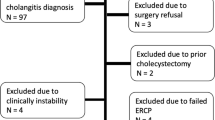Abstract
Background
Transvaginal rigid-hybrid transluminal endoscopic cholecystectomy (tvCCE) has become a routine procedure in some laparoscopic departments in recent years. Although intraoperative cholangiography is an important adjunct to cholecystectomy, its feasibility and safety in tvCCE have not been demonstrated to date.
Methods
Patients undergoing tvCCE between April and October 2012 were included in this study. An intraoperative cholangiogram was obtained routinely for all the patients. Patient characteristics, operation data, feasibility, and duration of the cholangiography as well as the postoperative course were recorded prospectively.
Results
For 32 (97 %) of the 33 patients enrolled in this study, intraoperative cholangiography could be performed successfully. The median duration of cholangiography was 6 min (interquartile range, 4–7 min). Common bile duct stones were detected in three patients (10 %). Laparoscopic bile duct revision with the aid of one additional port was successful in two of these patients. One patient needed postoperative endoscopic retrograde cholangiopancreatography due to the impossibility of extracting an impacted prepapillary concrement. One operation was converted to a four-port laparoscopic cholecystectomy. One additional port was used in 11 patients (33 %) and two additional ports in three patients (9 %). Three intraoperative minor complications (9 %) and one postoperative minor complication (3 %) occurred.
Conclusions
Intraoperative cholangiography during tvCCE is feasible, safe, and easy to perform. The need for intraoperative cholangiography no longer represents a contraindication for tvCCE.




Similar content being viewed by others
References
Zornig C, Emmermann A, von Waldenfels HA, Mofid H (2007) Laparoscopic cholecystectomy without visible scar: combined transvaginal and transumbilical approach. Endoscopy 39:913–915
Zornig C, Mofid H, Emmermann A, Alm M, von Waldenfels HA, Felixmüller C (2008) Scarless cholecystectomy with combined transvaginal and transumbilical approach in a series of 20 patients. Surg Endosc 22:1427–1429
Zornig C, Mofid M, Emmermann A, Alm M, Waldenfels H-A, Freimüller C (2009) NOTES-Cholecystektomie ohne Narben. Chirurg 80:364–369
Linke GR, Tarantino I, Hoetzel R, Warschkow R, Lange J, Lachat R, Zerz A (2010) Transvaginal rigid-hybrid NOTES cholecystectomy: evaluation in routine clinical practice. Surg Endosc 42:571–575
Cardoso Ramos A, Muratami A, Galvoneto M, Santana Galvao M, Souza Silva AC, Gonzalo Canseco E, Moyes Y (2008) NOTES transvaginal video-assisted cholecystectomy: first series. Endoscopy 40:572–575
Zornig C, Siemssen L, Emmermann A, Alm M, von Waldenfels HA, Felixmüller C, Mofid H (2011) NOTES cholecystectomy: matched-pair analysis comparing the transvaginal hybrid and conventional laparoscopic techniques in a series of 216 patients. Surg Endosc 25:1822–1826
Van den Boezem PB, Kruyt FM, Stommel MW, Samlal RA, Sietses C (2011) Cholecystectomy without visible scars: the transvaginal method. Ned Tijdschr Geneeskd 155:A3617
Santos BF, Teitelbaum EN, Arafat FO, Milad MP, Soper NJ, Hungness ES (2012) Comparison of short-term outcomes between transvaginal hybrid NOTES cholecystectomy and laparoscopic cholecystectomy. Surg Endosc 26:3058–3066
Solomon D, Shariff AH, Silasi DA, Duffy AJ, Bell RL, Roberts KE (2012) Transvaginal cholecystectomy versus single-incision laparoscopic cholecystectomy versus four-port laparoscopic cholecystectomy: a prospective cohort study. Surg Endosc 26:2823–2827
Linke GR, Tarantino I, Bruderer T, Celeiro J, Warschkow R, Tarr PE, Müller-Stich BP, Zerz A (2012) Transvaginal access for NOTES: a cohort study of microbiological colonization and contamination. Endoscopy 44:684–689
Agarwal BB, Mahajan KC (2010) Laparoscopic biliary tract injury prevention: zero tolerance, error free performance. Surg Endosc 24:728–729
Kum CK, Eypasch E, Lefering R, Paul A, Neugebauer E, Troidl H (1996) Laparoscopic cholecystectomy for acute cholecystitis: Is it really safe? World J Surg 20:43–48
Schmitz SF, Krähenbühl S, Krähenbühl L (2010) Bile duct injury and use of cholangiography during laparoscopic cholecystectomy. Br J Surg 98:391–396
Connor S, Garden OJ (2006) Bile duct injury in the era of laparoscopic cholecystectomy. Br J Surg 93:158–168
Ford JA, Soop M, Du J, Loveday BP, Rodgers M (2012) Systematic review of cholangiography in cholecystectomy. Br J Surg 99:160–167
Nuzzo G, Giuliante F, Giovanni I, Ardito F, D’Acapito F, Vellone M, Murazio M, Capelli G (2005) Bile duct injury during laparoscopic cholecystectomy: results of an Italian national survey on 56,591 cholecystectomies. Arch Surg 140:986–992
Davidoff AM, Pappas TN, Murray EA, Hilleren DJ, Johnson RD, Baker ME, Newman GE, Cotton PB, Meyers WC (1992) Mechanisms of major bile duct injury during laparoscopic cholecystectomy. Ann Surg 215:196–202
Tylor OM, Sedman PC, Jones BM, Royston CM, Arulampalam T, Wellwood J (1997) Laparoscopic cholecystectomy without intraoperative cholangiogram: 2,038 cases over a 5-year period in two district general hospitals. Ann R Coll Surg Engl 79:376–380
Dindo D, Demartines N, Clavien PA (2004) Classification of surgical complications: a new proposal with evaluation in a cohort of 6,336 patients and results of a survey. Ann Surg 240:205–213
Trichat S (2003) Three-port versus four-port laparoscopic cholecystectomy. Surg Endosc 17:1434–1436
Strasberg SM, Hertl M, Soper NJ (1995) An analysis of the problem of biliary injury during laparoscopic cholecystectomy. J Am Coll Surg 180:101–125
Vettoretto N, Saronni C, Harbi A, Balestra L, Taglietti L, Giovanetti M (2011) Critical view of safety during laparoscopic cholecystectomy. J Laparoendosc Surg 15:322–325
Linke GR, Luz S, Janczak J, Zerz A, Schmied BM, Siercks I, Warschkow R, Beutner U, Tarantino I (2013) Evaluation of sexual function in sexually active women 1 year after transvaginal NOTES: a prospective cohort study of 106 patients. Langenbecks Arch Surg 398:139–145
Disclosures
Önder Ögredici, Georg R. Linke, Sebastian Lamm, Rachel Rosenthal, Andreas Zerz, and Daniel C. Steinemann have no conflicts of interest or financial ties to disclose.
Author information
Authors and Affiliations
Corresponding author
Rights and permissions
About this article
Cite this article
Ögredici, Ö., Linke, G.R., Lamm, S. et al. Routine cholangiography during rigid-hybrid transvaginal natural orifice transluminal endoscopic cholecystectomy. Surg Endosc 28, 910–917 (2014). https://doi.org/10.1007/s00464-013-3246-3
Received:
Accepted:
Published:
Issue Date:
DOI: https://doi.org/10.1007/s00464-013-3246-3




